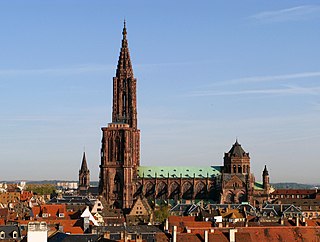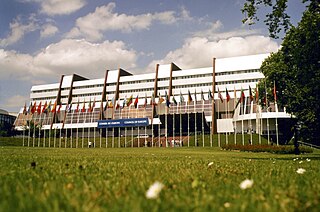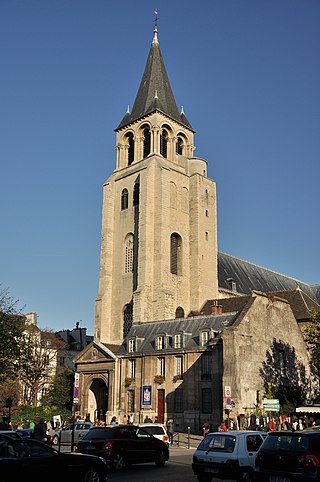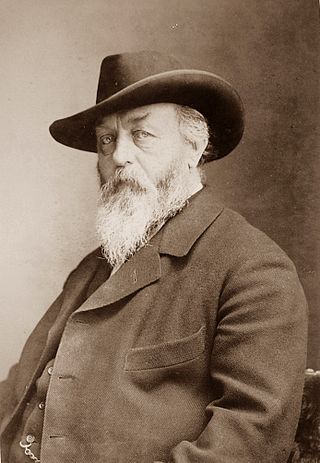
Strasbourg is the prefecture and largest city of the Grand Est region of eastern France and the official seat of the European Parliament. Located at the border with Germany in the historic region of Alsace, it is the prefecture of the Bas-Rhin department.
The year 1892 in architecture involved some significant events.
The year 1806 in architecture involved some significant events.

Baron Theophil Edvard von Hansen was a Danish architect who later became an Austrian citizen. He became particularly well known for his buildings and structures in Athens and Vienna, and is considered an outstanding representative of Neoclassicism and Historicism.
The year 1893 in architecture, involved some significant architectural events and new buildings.

The Palace of Europe is a building located in Strasbourg, France, that has served as the seat of the Council of Europe since 1977 when it replaced the "House of Europe". Between 1977 and 1999 it was also the Strasbourg seat of the European Parliament.

The Palais Rohan in Strasbourg is the former residence of the prince-bishops and cardinals of the House of Rohan, an ancient French noble family originally from Brittany. It is a major architectural, historical, and cultural landmark in the city. It was built next to Strasbourg Cathedral in the 1730s, from designs by Robert de Cotte, and is considered a masterpiece of French Baroque architecture. Since its completion in 1742, the palace has hosted a number of French monarchs such as Louis XV, Marie Antoinette, Napoleon and Joséphine, and Charles X.

Strasbourg-Ville station is the main railway station in the city of Strasbourg, Bas-Rhin, France. It is the eastern terminus of the Paris-Est–Strasbourg-Ville railway. The current core building, an example of historicist architecture of the Wilhelminian period, replaced a previous station inaugurated in 1852, later turned into a covered market and ultimately demolished.
With over 20 million passengers in 2018, Strasbourg-Ville is one of the busiest railway stations in France, second only to Lyon-Part-Dieu outside of the Île-de-France.

The National Academic Library is a public library in Strasbourg, France. It is located on Place de la République, the former Kaiserplatz, and faces the Palais du Rhin.

The city of Paris has notable examples of architecture of every period, from the Middle Ages to the 21st century. It was the birthplace of the Gothic style, and has important monuments of the French Renaissance, Classical revival, the Flamboyant style of the reign of Napoleon III, the Belle Époque, and the Art Nouveau style. The great Exposition Universelle (1889) and 1900 added Paris landmarks, including the Eiffel Tower and Grand Palais. In the 20th century, the Art Deco style of architecture first appeared in Paris, and Paris architects also influenced the postmodern architecture of the second half of the century.

The National Theatre of Strasbourg is a palace building on Strasbourg's Place de la République, now occupied by a theatre company of the same name, the National Theatre of Strasbourg.

The Palais de Justice of Strasbourg is a large 19th-century neo-Greek building in the Tribunal quarter of the Neustadt district of Strasbourg, France, which houses Strasbourg's main court, the Tribunal de Grande Instance.

Georg Peter Hermann Eggert was a German architect. He designed important public buildings such as the Frankfurt Main Station and the New Town Hall in Hannover, often in the style of Neo-Renaissance.

The Neustadt is a district of Strasbourg, Bas-Rhin, France. In 2017, the heart of the district was listed as a World Heritage Site by UNESCO, as an extension of the site including the older city centre and Strasbourg Cathedral. The district is a unique example of city planning, merging the Haussmannian model with elements of German architecture and urban planning.

The Palais des Fêtes is a music venue in the Neustadt district of Strasbourg, in the French department of the Bas-Rhin. Built for the male choral society of Strasbourg in 1903, it has served as the principal concert hall of the city and home to the Orchestre philharmonique de Strasbourg until 1975. It has been classified as a Monument historique since 2007.

The Strasbourg Opera House, located on Place Broglie on the Grande Île in the city center of Strasbourg, in the French department of the Bas-Rhin, is the main seat and mother house of the opera company Opéra national du Rhin. It has been classified as a Monument historique since 1921.

The Episcopal Palace, formerly known as the Hôtel du grand Doyenné, is the seat of the Archdiocese of Strasbourg. A French Baroque hôtel particulier of the 1720s, it is located between Rue du Parchemin and Rue Brûlée, near Place Broglie, on Grande Île, the historic city center of Strasbourg, in the French department of the Bas-Rhin, Alsace. It has been classified as a monument historique since 1929.

The Place de la République is one of the main squares of the city of Strasbourg, France. It is surrounded on three sides by five buildings only, of which none is residential: the Palais du Rhin, the National and University Library, the Théâtre national de Strasbourg, the Préfecture of Grand Est and Bas-Rhin, and the tax center Hôtel des impôts. All of these buildings are classified as monuments historiques. The fourth side of the square is devoid of buildings.

Saint-Pierre-le-Jeune Catholic Church is a late 19th-century Catholic church dedicated to Saint Peter in Strasbourg, France. It is not to be confused with the medieval Saint-Pierre-le-Jeune Protestant Church in the same city.

Carl Wilhelm Ernst Schäfer was a German architect and university professor.


















